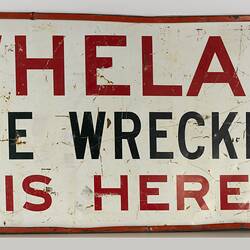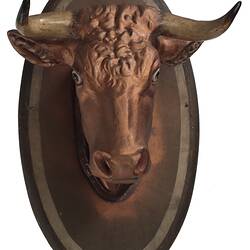The Bull and Mouth Hotel was located at 283-91 Bourke Street, on the south side, between Swanston Street and Union Lane (on the Western side of Swanston Street, towards Elizabeth Street). It was built in about 1850 by Matt Cantlon, replacing the Eagle Inn, one of the oldest drinking houses of the city. The Eagle had been built in 1840, and according to Garryowen, a chronicler of early Melbourne, it did not have the highest reputation.
The Bull and Mouth was one of the most popular hotels during the Goldrush decade of the 1850s. When he visited the city in 1853, English traveller and writer William Kelly described it as: ".the great popular central tap of the day, in what may be called Mid-Bourke-street, the nucleus of the vast subsequent cab and omnibus innovation, and then a favourite rallying point, from its contiguity to the Post Office, the close neighbourhood of rifle-galleries, bowling-saloons, and billiard-tables. The bar was really a sight for a stranger, with its close packed crowd in front, skirted by outsiders, who were served over the hats of the inner ranks. Effervescing drinks frequently boiling over in the transit, and nobblers overturning in trayfuls on the brandy-proof heads of the indifferent multitude. Whenever a man fell or retired, the gap was filled up like magic by a fresh customer, so that the demand never flagged, the tide never ebbed, the fusillade never intermitted: "Nobblers for five!" - "Six ales!" - "Rounds of Old Toms!" - "Whiskies neat!" "Nobblers," "Toms," "Ales" with only an ever-varying transposition in precedency, continued without ceasing, at the uniform rate of one shilling, all day long. Then there were sliding panels at the back communicating with the eating rooms, where crescents of empty trays were always waiting for repletion, and large pigeon-holes, too, at the side, opening into the hall, beset with shouldering groups.The upper apartments were as fully occupied as those below, if I might judge from the torrents of waiters of both sexes rushing down or sidling up in obedience to the law of demand and supply, the stair steps positively dripping alcohol, and the dropsical oakum mat at the bottom squirting juices under every tread. The low atmosphere was one of spirituous essences, as dense as a Scotch mist, which I verily believe would inebriate a person of weak constitutional powers, and over it rolled, in murky curls, a thick fog of vile tobacco-smoke that would poison a rookery. C------m [Kelly's guide through Melbourne at that time] assured me that they often received as much as 500 [pounds] per day - two thirds profit - and that the good will of the concern, with only a two years lease to run, would fetch 12,000 [pounds]." (Kelly, 1977, pp. 83-84)
This bustling centre of Melbourne's early social scene was captured in a range of sketches of the city, including one by the famous artist Thomas Gill (1854), and another by Samuel Calvert in 1865, which clearly shows the exterior of the hotel. Whereas the plaster Bull's head that Museum Victoria received from Whelan the Wrecker was clearly made to be displayed indoors, the hotel had a very literal 'bull and mouth' sign outdoors, of a bull above a grinning mouth.
Michael Cannon described the Bull and Mouth as the only one of the businesses in its section of Bourke Street to have "survived the retail shakeout of the gold rush," (Cannon, 1993, p. 324) while all the businesses around it were replaced. It went on to survive until about 1930, when the site became part of Woolworths' central Melbourne store.
This text is derived in part from research materials gathered by Patricia Draper, Intern at Museum Victoria, 1997.
References:
Annear, Robyn (2005). A City Lost and Found: Whelan the Wrecker's Melbourne, Black Inc., Melbourne.
Cannon, Michael (1993). Melbourne after the Gold Rush, Lochhaven Books, Main Ridge.
Draper, Patricia, (1997). 'Research Notes', Unpublished Mss., Museum Victoria Collection.
Kelly, William (1977). Life in Victoria or Victoria in 1853 and Victoria in 1858 (originally published 1859), Lowden Publishing, Kilmore, pp.83-84.
More Information
-
Keywords
construction industry, architectural feature, Cultures and histories : Melbourne and Victoria
-
Localities
-
Authors
-
Article types
![Sign - Bull and Mouth Hotel [bull's head]](/content/media/29/171629-small.jpg)

